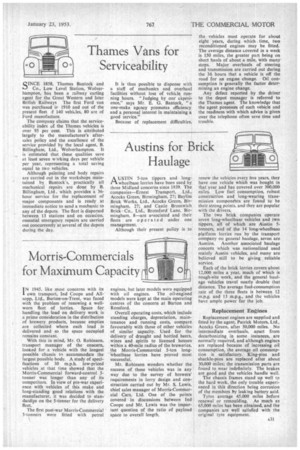Austins for Brick Haulage
Page 33

If you've noticed an error in this article please click here to report it so we can fix it.
1-1. A USTIN 5-ton tippers and long wheelbase lorries have been used by three Midland concerns since 1939. The companies—Ernest Transport, Ltd., Acocks Green, Birmingham, 27; Bayliss Brick Works, Ltd., Acocks Green, Birmingham, 27; and Castle Bromwich Brick • Co., Ltd., Bromford Lane, Birmingham, 8—are associated and their fleets are operated under one management.
Although their present policy is to IN 1945. like roost concerns with its -I own transport, Ind Coope and Allsopp, Ltd., Burton-on-Trent, was faced with the problem of renewing a wellworn fleet of lorries. Space for handling the load on delivery work is a prime consideration in the distribution of brewery products, because empties are collected where each load is delivered and so the space occupied remains constant.
With this in mind, Mr. 0. Robinson, transport manager of the concern, looked for a vehicle with the longest possible chassis to accommodate the largest possible body, A study of specifications of 30 m.p.h. low-priced vehicles at that time showed that the Morris-Commercial forward-control 5tonner was longer than any of its competitors. In view of pre-war experience with vehicles of this make and long-standing good relations with the manufacturer, it was decided to start. dardize on the 5-tonner for the delivery fleet.
The first post-war Morris-Commercial 5-tonners were fitted with petrol engines, but later models were equipped with oil engines. The oil-engined models were kept at the main operating centres of the concern at Burton and Romford.
Overall operating costs, which include standing charges, depreciation, maintenance and running costs, compare favourably with those of other vehicles of similar capacity. Used for the delivery of draught and bottled beers, wines and spirits to licensed houses within a 40-mile radius of the breweries, the Morris-Commercial 5-ton longwheelbase lorries have proved most successful.
Mr. Robinson wonders whether the success of these vehicles was in any way due to the survey of brewers' requirements in lorry design and construction carried out by Mr. S. Lewis, chief sales manager of Morris-Commercial Cars, Ltd. One of the points covered in discussions between Ind Coope and Mr. Lewis was the important question of the ratio of payload space to overall length.
renew the vehicles every live years, they have one vehicle which was bought in that year and has covered over 300,000 miles. Low fuel consumption, robust construction and long-wearing transmission components are found to be their strong points, and they are popular with the drivers.
The two brick companies operate seven long-wheelbase vehicles and two tippers, all of which are Austin 5tanners, and of the 14 long-wheelbase platform lorries run by the transport company on general haulage, seven are Austins. Another associated haulage concern which was nationalized used mainly Austin vehicles, and many are believed still to be giving reliable service.
Each of the brick lorries covers about 12,000 miles a year, much of which is rough-site work, and the general haulage vehicles travel nearly double that distance. The average fuel-consumption rate of the three fleets is between 12 m.p.g. and 13 m.p.g., and the vehicles have ample power for the job.
Replacement Engines Replacement engines are supplied and fitted by the agent, Patrick Motors, Ltd.. Acocks Green, after 50,000 miles. No intermediate overhauls, apart from decarbonizing in some instances, are normally required, and although engines are replaced because of increasing oil consumption, the average oil consumption is satisfactory. King-pins and shackle-pins are replaced after about 30,000 miles; the transmission parts are found to wear indefinitely. The brakes are good and the vehicles handle well.
The chassis frames stand up well to the hard work, the only trouble experienced in this direction being corrosion of the members by leaking battery acid.
Tyres average 45,000 miles before renewal or remoulding. As much as 65,000 miles has been obtained, and the companies are well satisfied with the original tyre equipment.
























































































































































